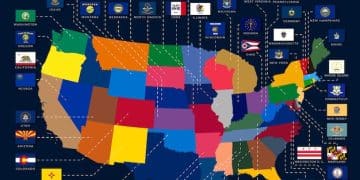Federal Housing Assistance Programs in the US: Are You Eligible?

Are You Eligible? A Comprehensive Guide to Federal Housing Assistance Programs in the US unravels the complexities of government aid, providing a clear roadmap to navigate eligibility criteria, application processes, and available resources for those seeking housing assistance.
Navigating the landscape of federal housing assistance can seem daunting, but understanding your eligibility is the first step toward securing stable housing. This guide, titled Are You Eligible? A Comprehensive Guide to Federal Housing Assistance Programs in the US, provides a comprehensive overview of the key programs, their requirements, and how to apply.
Understanding Federal Housing Assistance Programs
Federal housing assistance programs are designed to provide safe and affordable housing to low-income families, the elderly, and people with disabilities. These programs offer a variety of assistance options, including rental assistance, public housing, and homeownership assistance. Knowing which programs are available and what they offer is crucial in determining where to start your search.
Types of Housing Assistance Programs
The U.S. Department of Housing and Urban Development (HUD) administers many of the federal housing assistance programs. These programs fall into several categories, each designed to meet specific housing needs.
- Rental Assistance: Helps eligible families afford decent, safe, and sanitary housing in the private rental market.
- Public Housing: Provides affordable housing units owned and managed by local housing authorities.
- Homeownership Assistance: Offers programs to help low-income families become homeowners through mortgage assistance and other support.
Each of these types of programs has its own eligibility criteria and application process, so it’s important to understand the differences between them. By familiarizing yourself with these options, you can better assess which programs align with your needs and qualifications.

In summary, federal housing assistance programs offer a lifeline to those who struggle to afford adequate housing. By understanding the different types of assistance available, individuals can take the first step towards securing stable and affordable housing.
Key Federal Housing Programs and Their Eligibility
Several key federal housing programs provide vital assistance to eligible individuals and families. Understanding the specifics of each program, including its eligibility criteria, is essential for determining which options are most suitable.
Section 8 Housing Choice Voucher Program
The Section 8 Housing Choice Voucher Program is arguably the most well-known federal housing assistance program. It provides rental assistance to eligible families, allowing them to choose housing in the private market.
- Income Limits: Typically, household income must be below 50% of the median income for the area. Some areas may have lower income limits.
- Family Definition: Includes families with children, elderly individuals, and people with disabilities.
- Citizenship Status: Applicants must be U.S. citizens or have eligible immigration status.
Applicants must go through their local Public Housing Agency (PHA) to apply for the program. Once approved, the voucher covers a portion of the rent, with the tenant paying the difference. The PHA inspects the housing to ensure it meets safety and quality standards.
Public Housing Program
The Public Housing Program provides affordable housing units owned and managed by local housing authorities. Eligibility requirements are similar to those for the Section 8 program.
- Income Limits: Generally, household income must be below 80% of the median income for the area.
- Family Definition: Includes families, elderly individuals, and people with disabilities.
- Background Checks: Housing authorities conduct background checks to ensure applicants do not have a history of criminal activity that would threaten the safety of other residents.
Public housing units are available in various sizes to accommodate different family sizes. Rent is typically based on a percentage of the tenant’s income.

Understanding the key federal housing programs and their eligibility criteria is essential for anyone seeking housing assistance. The Section 8 Housing Choice Voucher Program and the Public Housing Program are two of the most significant options available, each with its own set of requirements and benefits.
Navigating the Application Process for Housing Assistance
Applying for federal housing assistance can seem complex, but understanding the steps involved can make the process more manageable. Each program has its own application process, so it’s important to follow the specific instructions provided by the administering agency.
Finding Your Local Public Housing Agency (PHA)
The first step in applying for many federal housing programs is to find your local Public Housing Agency (PHA). The PHA is responsible for administering the programs in your area and determining eligibility.
You can find your local PHA by visiting the HUD website or by contacting your local government. The PHA can provide information about available programs, eligibility requirements, and application procedures.
Completing the Application
Once you have located your PHA, you will need to complete an application. The application will typically require information about your income, family size, and housing history.
Be sure to provide accurate and complete information on the application. Any false or misleading information could result in your application being denied. You may also need to provide documentation to support the information you provide, such as pay stubs, tax returns, and identification.
Waiting Lists and Prioritization
Due to high demand, many housing assistance programs have waiting lists. The length of the waiting list can vary depending on the program and the area. Some PHAs may prioritize certain applicants, such as veterans, the elderly, or people with disabilities.
It’s important to inquire about the status of your application regularly and to keep your contact information up to date with the PHA.
Navigating the application process for housing assistance requires patience and attention to detail. By understanding the steps involved and providing accurate information, applicants can increase their chances of receiving assistance.
Understanding Income Limits and Eligibility Requirements
Income limits are a key factor in determining eligibility for federal housing assistance programs. These limits vary depending on the program and the area, and they are designed to ensure that assistance is targeted to those who need it most.
How Income Limits Are Determined
HUD sets income limits for each metropolitan area and non-metropolitan county in the United States. These limits are based on the median income for the area and are updated annually.
The income limits are typically expressed as a percentage of the median income, such as 50% or 80%. For example, if the median income for an area is $60,000, the 50% income limit would be $30,000.
Other Eligibility Factors
In addition to income limits, other factors can also affect eligibility for housing assistance. These factors may include family size, citizenship status, and housing history.
- Family Size: Larger families typically have higher income limits than smaller families, as they have greater housing needs.
- Citizenship Status: Applicants must be U.S. citizens or have eligible immigration status to receive housing assistance.
- Housing History: PHAs may consider an applicant’s housing history, including any evictions or history of lease violations, when determining eligibility.
Understanding the income limits and other eligibility requirements for federal housing assistance programs is essential for determining whether you qualify for assistance. Be sure to check the specific requirements for the programs you are interested in applying for.
In conclusion, navigating income limits and eligibility requirements is crucial for anyone seeking federal housing assistance. Understanding how these limits are determined and what other factors can affect eligibility will help applicants assess their chances of receiving assistance.
Additional Resources and Support for Housing Assistance
Beyond the core federal housing programs, numerous additional resources and support services can help individuals and families secure stable housing. These resources can provide assistance with everything from finding affordable housing to navigating the application process.
Non-profit Organizations
Many non-profit organizations offer housing assistance services, such as counseling, rental assistance, and legal aid. These organizations can be a valuable resource for those who need help navigating the complex world of housing.
Some well-known non-profit organizations that offer housing assistance services include Habitat for Humanity, the National Low Income Housing Coalition, and the United Way.
State and Local Programs
In addition to federal programs, many states and local governments offer their own housing assistance programs. These programs may be tailored to meet the specific needs of the community and can provide additional options for those seeking housing assistance.
Check with your state and local government to see what housing assistance programs are available in your area. These programs may offer rental assistance, down payment assistance, or other forms of support.
Online Resources
A wealth of information about housing assistance is available online. Websites such as the HUD website and the National Housing Law Project website offer detailed information about federal housing programs and resources.
These resources can help you learn more about your rights as a tenant, find affordable housing, and navigate the application process.
Accessing additional resources and support can significantly improve your chances of securing stable housing. By leveraging the assistance offered by non-profit organizations, state and local programs, and online resources, individuals and families can navigate the complexities of the housing market and find the support they need.
Maintaining Compliance and Avoiding Common Pitfalls
Once you have secured housing assistance, it’s important to maintain compliance with the program requirements to avoid losing your benefits. Understanding the rules and regulations is critical for staying in good standing.
Reporting Income and Family Changes
Most housing assistance programs require you to report any changes in your income or family size. This information is used to determine your continued eligibility for the program and to calculate your rent.
Failure to report changes in a timely manner could result in your assistance being terminated. Be sure to follow the reporting requirements carefully and to keep your PHA informed of any changes in your circumstances.
Following Lease Agreements
If you are receiving rental assistance, you are still required to follow the terms of your lease agreement. This includes paying your rent on time, maintaining the property in good condition, and following any rules and regulations set by your landlord.
Violating your lease agreement could result in eviction and termination of your housing assistance.
Avoiding Fraud and Misrepresentation
It is illegal to provide false or misleading information to obtain housing assistance. This includes misrepresenting your income, family size, or other eligibility factors.
Committing fraud could result in criminal charges, fines, and termination of your housing assistance. Be honest and accurate when providing information to the PHA.
Maintaining compliance with program requirements is essential for preserving your housing assistance benefits. By reporting changes, following lease agreements, and avoiding fraud, you can ensure that you continue to receive the support you need.
| Key Point | Brief Description |
|---|---|
| 🏠 Section 8 Vouchers | Rental assistance for private market housing. |
| 🏢 Public Housing | Affordable units managed by local authorities. |
| 📝 Application Process | Apply via local PHA; expect waiting lists. |
| 💰 Income Limits | Vary by program and location; HUD sets limits. |
Frequently Asked Questions (FAQ)
▼
The Section 8 Housing Choice Voucher Program provides rental assistance to eligible low-income families, the elderly, and people with disabilities to afford housing in the private market. It’s a key federal initiative administered by local Public Housing Agencies (PHAs).
▼
You can find your local PHA by visiting the U.S. Department of Housing and Urban Development (HUD) website or by contacting your local government. The PHA directory on the HUD site offers an easy way to search for agencies in your area.
▼
Income limits vary depending on the specific program and your location. They are typically based on a percentage of the median income for your area, and HUD updates these limits annually. Always check the guidelines for your local PHA.
▼
When applying, gather documents verifying your income (pay stubs, tax returns), identity (driver’s license, passport), and family composition (birth certificates). Proof of U.S. citizenship or eligible immigration status is also typically needed.
▼
If denied, you have the right to appeal the decision. Review the denial notice carefully, understand the reasons for the denial, and follow the agency’s instructions for filing an appeal, typically within a specified timeframe.
Conclusion
Understanding and navigating federal housing assistance programs can be complex, but it is a crucial step towards securing stable and affordable housing. By familiarizing yourself with the different programs, their eligibility requirements, and the application process, you can increase your chances of receiving the assistance you need to build a better future.





